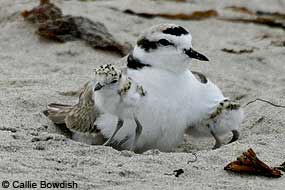|
You are viewing ARCHIVED content published online before January 20, 2025.
Please note that this content is NOT UPDATED, and links may not work. For current information,
visit https://www.nps.gov/aboutus/news/index.htm.
Contact: Natalie Gates, 415-464-5189 Contact: John Dell'Osso, 415-464-5135

The federally-threatened Western snowy plover nesting season is underway. Nesting inconspicuously between the tidal zone and upper reaches of coastal beaches, snowy plovers on the West Coast are faced with habitat loss, disturbance and predation, all of which have taken a toll on this species. Point Reyes National Seashore, one of the few remaining nesting grounds for this rare bird, typically supports 30 – 35 adult breeding plovers. With the partnership of PRBO Conservation Science, the snowy plover population has been monitored annually since 1995. Efforts to protect the plovers include roping off breeding habitat on upper sections of beaches and the construction of "exclosures" around their nests immediately after an egg is laid. To assure success occurs this nesting season, the closure of a small stretch of the Point Reyes Beach to dogs will again be enforced. Closing a portion of the Great Beach to dogs is important to minimize disturbance to nests, chicks and breeding adults during this critical time. Last year, only 1 in 3 chicks (a total of 24) survived in the Seashore. US Fish and Wildlife Service has set a goal of 32 fledged chicks and 64 adult birds in the park. "With increasing use and development pressures on California beaches, this species is facing an uphill battle to survive. It would be a real loss to have this species dwindle and disappear from the Seashore," stated park biologist Dr. Natalie Gates. Superintendent Don Neubacher added, "We have seen a growing understanding by the community and visitors of how important it is to protect plovers with some beach restrictions." He added, "We appreciate everyone’s support for closures." The portion of the Great Beach from 500 feet south of Kehoe Beach to ¼ mile north of North Beach parking lot (as signed) has been closed to dogs. The closures encompass less than five miles of this 12-mile beach area. As alternatives for park visitors with dogs, other popular beaches such as east Limantour Beach (to the right as you approach the beach) and Kehoe Beach remain open. All dogs in the park are required to be on a leash no longer than six feet. Plover exclosures are erected at the nest site and made of wire fencing. Plovers have easy access in and out of the wire mesh but the eggs are protected from disturbance and predators. Since 2001, the Seashore has received funds from the Point Reyes National Seashore Association to hire a ranger to coordinate the snowy plover docent program. The program uses volunteer docents to provide information and education on snowy plovers at beach trailheads during the highest visitation periods and on weekends. This program has been successful in reaching visitors with information on closures and their importance to the plover population at Point Reyes. Rangers and volunteer docents will be on-site again this season from Memorial Day through Labor Day. For more information on volunteering in the plover docent program at Point Reyes National Seashore, call (415) 464-5145. As part of a long-term strategy to improve critical dune habitat for plovers and other rare species, the Seashore initiated a dune restoration project in 2001. Nonnative European beachgrass has been removed from over 30 acres near Abbotts Lagoon since the project began. In 2007, snowy plovers used restored dune habitat for the fifth consecutive year, building 4 of 28 nests in the restoration areas. Please visit our expanded website at www.nps.gov/pore or www.prbo.org for more information on snowy plovers. -NPS- |
Last updated: February 28, 2015
